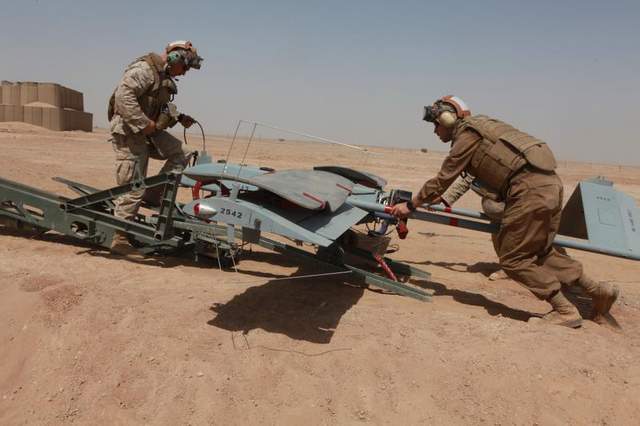 Officers who want a change of pace, and opportunity in a burgeoning community, can now apply for the fiscal 2014 unmanned aircraft system officer accession board.
Officers who want a change of pace, and opportunity in a burgeoning community, can now apply for the fiscal 2014 unmanned aircraft system officer accession board.
Slated to convene Sept. 4, the board will consider and select officers from any military occupational specialty to join the recently established 7315 mission commander military occupational specialty, which provides a permanent career path in the UAS community.
The accession board is part of a multipronged effort to create a robust UAS officer corps through initial accessions by newly minted officers just out of The Basic School at Marine Corps Base Quantico, Va., and with targeted lateral moves for officers who are several years into their careers.
Mission commander was made a primary MOS last year with the publication of the 2013 MOS Manual. Before that it was a nominal MOS, a secondary duty for officers in the 72 or 75 career fields, which includes air traffic controllers and pilots. That presented a problem. While enlisted Marines already had a dedicated UAS job, officers only served in the community for a few years before returning to their primary specialty to remain competitive for promotion. That made it difficult to build institutional knowledge in the community, aviation officials said.
Mission commanders supervise and coordinate UAS missions, directing not only combat missions but also administrative and supply functions of UAS operations.
“They direct the tactical employment of UASs in combat, and coordinate operations with other air and ground units,” according to the most recent MOS Manual, which details the duties of each job in the Marine Corps.
To be eligible for the board, officers should:
■Have fewer than 12 years of service, although those with more will be considered on a case-by-case basis and are encouraged to apply.
■Have at least 1.5 years’ time on station by Aug. 1 (they will have to complete two years’ time on station before reporting for MOS training).
■Submit an Aviation Selection Test Battery score and file it with the Naval Aerospace Medical Institute in Pensacola, Fla., by Aug. 30.
All unrestricted officers are eligible; however, those with forward air control, fires coordination, electronic attack or previous unmanned aerial vehicle experience are “especially encouraged to apply for transition,” according to Marine administrative message 321/13, authorized by Lt. Gen. Robert Schmidle, the deputy commandant for aviation, and signed June 28.
To apply, Marines must have their package endorsed by the first general officer in their chain of command and submit an electronic administrative action form via email no later than Aug. 28. For full details, refer to the MARADMIN, available online.
Those selected by the board will receive the 7315 MOS after completing two courses. The first is the Air Force’s Remotely Piloted Aircraft Course at Randolph Air Force Base, Texas, which lasts 22 weeks and includes 30 hours of aerial flight, including solo flight operations. The second is the RQ-7B Unmanned Aircraft Vehicle Course at Fort Huachuca, Ariz., which lasts three weeks.
Marines who earn the new MOS will incur two years of additional obligated service from the time they complete training. Additionally, they likely will not be allowed to execute permanent change-of-station orders that would take them outside of their new MOS for three years.
As the Marine Corps looks to update the service’s electronic warfare capabilities, it is investigating and testing ways to install electronic warfare payloads on large unmanned aircraft, Lt. Col. Jason C. Schuette, head of the service’s electronic warfare branch, told Marine Corps Times early this year. The service is retiring its EA-6B Prowlers, and the new F35-B Joint Strike Fighter and an array of UASs will eventually take over the EW mission.
That could spell increased career opportunity at a time when much of the service is downsizing.
Photo: Cpl. Aaron H. Gibson, Cpl. Joe A. Barnard, both unmanned aerial vehicle technicians and Lance Cpl. Randy C. Akaeze, a supply clerk cross-training into the unmanned aerial vehicle technician job field, all with Marine Unmanned Aerial Vehicle Squadron 3, prepare an RQ-7B Shadow for the first operational launch of a VMU-3 UAV from Camp Leatherneck, Afghanistan, June 30. – Cpl. Samantha H. Arrington/Marines
Source: Marine Corps Times

I am a retired commander of Pakistan Navy. I am a qualified drone pilot with 25 years of naval service in operation branch. Have worked on different appointments, including Command, Executive officer,UAS Mission commander etc. I am seeking a job in UAS field as Mission commander.
Please contact me my email address
cheenaali@gmail.com